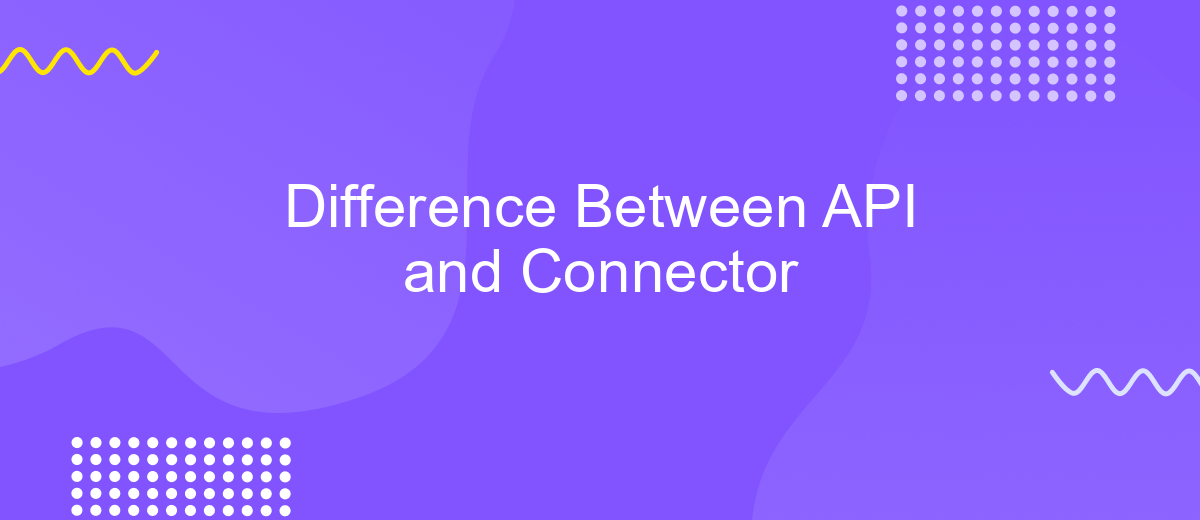Difference Between API and Connector
In the rapidly evolving landscape of technology, understanding the tools that facilitate seamless integration and communication between systems is crucial. APIs (Application Programming Interfaces) and connectors are two such tools that often come up in discussions about system interoperability. While both serve to link different software applications, they do so in distinct ways. This article explores the key differences between APIs and connectors, shedding light on their unique roles and functionalities.
Introduction
In today's digital landscape, understanding the distinction between an API and a connector is crucial for businesses looking to streamline their operations and enhance their technological infrastructure. An API, or Application Programming Interface, is a set of rules and protocols that allows different software applications to communicate with each other. It serves as a bridge, enabling the integration of various systems and facilitating seamless data exchange. On the other hand, a connector is a tool or component specifically designed to connect two or more systems, often simplifying the process of integration by providing pre-built solutions.
- APIs provide a framework for building custom integrations.
- Connectors offer ready-made solutions for specific applications.
- APIs require more technical expertise compared to connectors.
- Connectors can reduce development time and complexity.
As organizations continue to adopt digital solutions, the choice between using an API or a connector becomes pivotal. While APIs offer flexibility and customization, connectors provide ease of use and rapid deployment. Understanding these differences helps businesses make informed decisions that align with their strategic goals, ensuring efficient and effective integration of their technological ecosystems.
API vs Connector

APIs (Application Programming Interfaces) and connectors are both crucial tools in the realm of software integration, yet they serve distinct roles. An API is essentially a set of rules and protocols that allow different software applications to communicate with each other. APIs enable developers to access certain features or data of an application without needing to understand its internal workings. They are fundamental in creating seamless integrations between different software systems, facilitating data exchange and functionality extension.
Connectors, on the other hand, act as bridges that link APIs to various applications or services. They simplify the integration process by providing pre-built solutions that eliminate the need for custom coding. For instance, ApiX-Drive offers connectors that allow businesses to automate workflows by linking different apps effortlessly. By using connectors, companies can save time and resources, ensuring efficient data flow between systems. While APIs are the backbone of integration, connectors make the process more accessible and user-friendly, especially for those without extensive technical expertise.
Benefits of Using an API

APIs, or Application Programming Interfaces, are essential tools in modern software development, enabling seamless communication between different software systems. By using APIs, developers can integrate third-party services, enhance functionality, and streamline processes without reinventing the wheel. This not only saves time and resources but also allows for greater flexibility and scalability in application development.
- Efficiency: APIs allow developers to leverage existing solutions, reducing the need to build from scratch.
- Scalability: By using APIs, applications can easily scale as they can integrate new functionalities and services as needed.
- Interoperability: APIs enable different systems to communicate, fostering better integration and collaboration between services.
- Innovation: APIs provide the building blocks for developers to create innovative solutions by combining various services and functionalities.
- Cost-Effectiveness: Reducing development time and resources, APIs help lower overall project costs.
Overall, APIs are invaluable in creating robust, efficient, and scalable applications. They empower developers to focus on core functionalities while leveraging external services to enhance their applications, fostering an environment of innovation and collaboration.
Benefits of Using a Connector

Connectors serve as vital tools in the integration of various software applications, streamlining communication and data transfer between distinct systems. By acting as intermediaries, connectors simplify complex integration processes, reducing the need for extensive coding and development efforts. This efficiency not only saves time but also minimizes potential errors, ensuring smoother operations.
One of the primary advantages of using connectors is their ability to enhance interoperability. They bridge gaps between disparate systems, enabling seamless data flow and improving overall productivity. Connectors are designed to be user-friendly, often requiring minimal technical expertise to implement, which democratizes access to advanced integration capabilities.
- Streamlined integration processes
- Reduced need for extensive coding
- Improved data flow and interoperability
- User-friendly implementation
- Cost-effective solution for businesses
Furthermore, connectors provide a cost-effective solution for businesses looking to leverage existing systems without the need for complete overhauls. By facilitating easy integration, they allow organizations to adapt quickly to changing technological landscapes, maintaining competitiveness in their respective industries. As a result, connectors are indispensable in modern IT environments, offering flexibility and scalability in system integration.
- Automate the work of an online store or landing
- Empower through integration
- Don't spend money on programmers and integrators
- Save time by automating routine tasks
Conclusion
In conclusion, understanding the difference between APIs and connectors is crucial for optimizing digital integration strategies. APIs serve as powerful tools that allow different software applications to communicate seamlessly, offering a flexible and versatile approach to data exchange. They are essential for developers who seek to build custom solutions and require a high degree of control over their integrations. Conversely, connectors provide a more user-friendly solution, allowing non-developers to integrate applications without extensive coding knowledge. They offer a simplified interface for connecting disparate systems, making them ideal for businesses that need quick and efficient integration solutions.
For organizations looking to streamline their integration processes, services like ApiX-Drive can be invaluable. ApiX-Drive provides an intuitive platform that bridges the gap between complex APIs and user-friendly connectors, enabling businesses to automate workflows with ease. By leveraging such platforms, companies can enhance their operational efficiency without the need for extensive technical expertise. Ultimately, both APIs and connectors have their unique advantages, and understanding when to use each can significantly impact the success of an organization's integration efforts.
FAQ
What is the main difference between an API and a connector?
Can I use an API without a connector?
Why would I choose a connector over directly using an API?
How do connectors simplify the integration process?
Are there limitations to using connectors compared to APIs?
Strive to take your business to the next level, achieve your goals faster and more efficiently? Apix-Drive is your reliable assistant for these tasks. An online service and application connector will help you automate key business processes and get rid of the routine. You and your employees will free up time for important core tasks. Try Apix-Drive features for free to see the effectiveness of the online connector for yourself.


